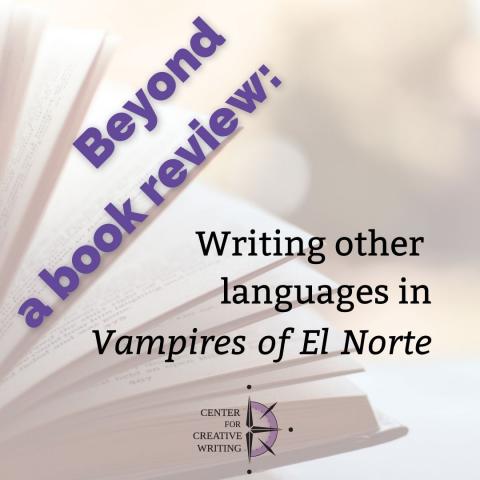
Shawna Ayoub moves "beyond a book review" in not only recommending great books by diverse writers but highlighting a technique to apply to your own writing.
Vampires of El Norte, by Isabel Cañas
Isabel Cañas is a Mexican American writer and author of Vampires of El Norte, a historical fantasy with a speculative take on vampires. Her novel takes place in 1846 when the United States attacks Mexico. Main characters Nena and Néstor are separated by tragedy. Years later, they come back together to fight the Anglos—Nena as a curandera working to heal Mexican soldiers, and Néstor as a soldier in the fray.
Néstor and Nena’s reunion is as fraught as their separation, but they are soon forced to look past their shared history in order to survive the greatest threat Mexico has ever seen. What are rumored to be vampires are wandering the land, leeching soldiers and civilians of their lives. Nena works to call back the spirits of the afflicted only to recall something similar happening to her. Something Néstor witnessed and is unable to articulate.
The pair embark on a journey to return to their original home settlement and protect their families. On their way, the origin of the vampires becomes clear.
Language(s) as invitation
This story is full of romance, sweeping landscapes, fantastic threats, and lurking horror. Its speculative look at vampires reimagines weapons of mass destruction and corrects for the more common orientation of terrorism. Cañas uses fantasy to explore the structures of power throughout history to thrilling effect.
This book kept me on the edge of my seat, even resulting in a midnight scare when I was up late reading, made a trip to the bathroom, and returned to bed to find my partner was not where I left her. She had also gotten up to use the bathroom. When I saw her shadowy figure near the bedroom door, my mind instantly classified her as a vampire and I screamed. And it wasn’t just any scream. It came from my toes and took a full hour of laughter afterward to overcome. Read before bedtime with care!
An aspect of books I haven’t yet spoken of in these reviews is languages. This novel includes plenty of Spanish, as it should, given that it takes place in Mexico among native Spanish speakers. However, the Spanish is balanced with English in a way that does not alienate non-Spanish speakers. Rather, it is an invitation into culture through language. This is a difficult achievement because humans do tend to be ethnocentric. (And that’s a big part of why this series of reviews exists!) With that in mind, I want to offer a writing prompt that encourages us to think about the languages we speak and how we can share them.
A writing prompt
First, a brief story: When I was four, my younger sister was born. At the time, our home language was Arabic, but my grandparents and aunt were unable to stay with us and had to return to Lebanon. For reasons of pain, my father stopped speaking Arabic full-time, and English became our home language. I’m not sure that it was a result of the switch, but my younger sister and I developed a third language that we spoke together that consisted largely of hums and clicks. We spoke it for several years as fluently as Pig Latin or any other made-up language, except it was mostly exclusive to us.
Languages exist where we make them. We are born with them, sure. But we speak languages with our hands, our bodies, our faces, our voices, to ourselves, with others, with animals, through writing, through visual arts, and in myriad other ways. Think about it—what languages do you speak? What languages have you spoken? When and why have you spoken them? Interpret “speaking” broadly, the way an act of service “speaks” love, for example.
Write a story that features a language other than English (or other than your preferred writing language). Make the main character the one who uses this second language. Do not cast the character as “special” for using this language. The goal here is to avoid othering and practice inclusion by normalizing the use of alternate communication.
Take your time in considering and choosing your language and approach, then reflect on the process. What challenges did you face with this exercise? What effect did using a second language have on your writing?
If you want to read this novel for yourself, consider purchasing Vampires of El Norte at Bookshop.org and supporting independent bookstores across the U.S.
Related reading
Beyond a Book Review: Uncertain futures in How High We Go in the Dark
Beyond a Book Review: Sentences as paragraphs in The Last White Man
Beyond a Book Review: Alternate futures in Womb City
Beyond a Book Review: Beginning at the End in Tomb Sweeping
Beyond a Book Review: The “What if?” of The Deep Sky
Beyond a Book Review: Grief and Hope in All We Are Told Not to Touch
Beyond a Book Review: Once Upon a Time in Dovelion
Beyond a Book Review: Narrators and Compassion in Finding La Negrita
Beyond a Book Review: Research as Connection in Through the Banks of the Red Cedar
Beyond a Book Review: Intuition in River Woman, River Demon
Beyond a Book Review: Timeline(s) in Becoming AppalAsian
Beyond a Book Review: Unwieldy Creatures and retelling our stories
Beyond a Book Review: Containers as safe spaces in Nonwhite and Woman
Beyond a Book Review: Footnotes in Belly to the Brutal
Want to receive prompts, tips, and inspiration like this in your inbox every Sunday morning? Join our email list community! You will receive weekly advice, a year’s worth of weekly writing prompts as a FREE download, and be eligible to participate in our monthly photo prompt contest for a chance to share an original piece of writing with our community of more than 2,500 writers.
